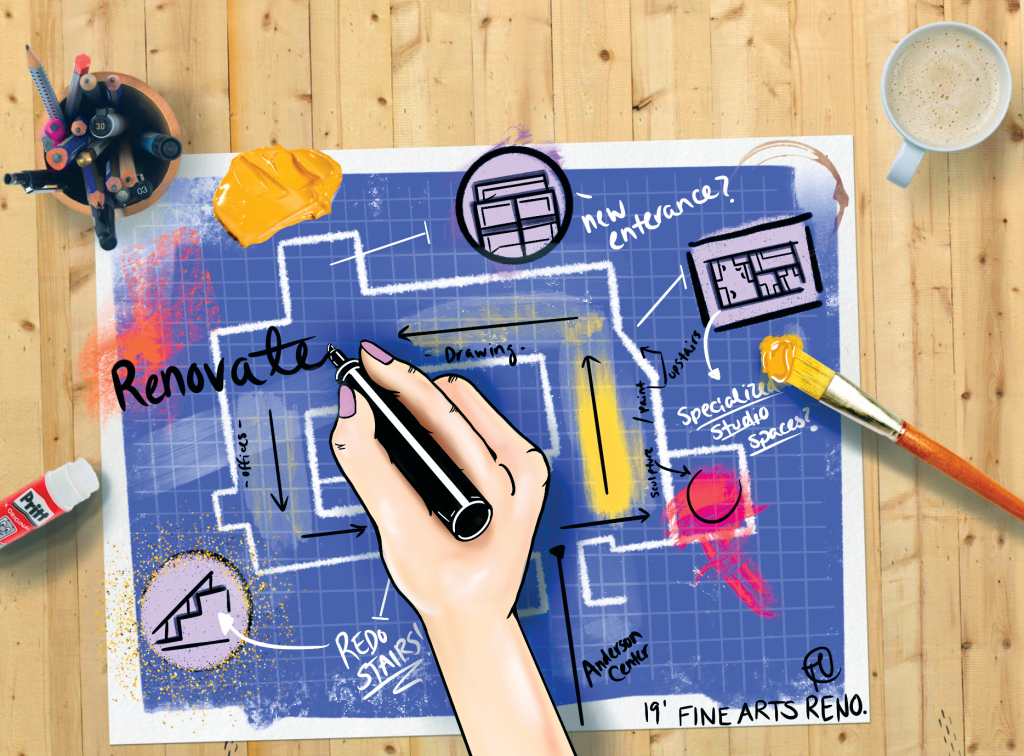Binghamton University President Harvey Stenger hinted at changes coming for art students and other Fine Arts Building frequenters in his annual State of the University address on Oct. 17, when he posed the possibility of creating a “master plan” to address student and faculty concerns about the building’s spacing and functionality.
“[Fine Arts] need a master plan, they need a better building, so we will spend the next year putting together a plan,” Stenger said. “But we don’t have the money yet. If we get a good plan together, and we bring that to SUNY, the money will flow.”
Besides minor retouches over the years, the Fine Arts Building has not been significantly altered since its most recent construction 35 years ago. According to the Facilities Master Plan Final documents from 2013, the L-wing portion was constructed in 1960, the Memorial Courtyard in 1966 and the Anderson Center in 1985. Andrew Walkling, a dean’s professor of art history, English and theatre, said the lack of significant renovations is a result of a lacking budget and few alumni connections.
“We haven’t really fully tapped into Binghamton University’s alumni network in the arts,” Walkling said. “I’m well aware that people are not, not fixing these buildings just to be annoying. They’re doing it because they have budgetary considerations that they have to take into account.”
During his address, Stenger also floated the possibility of creating a School of Fine Arts, a move he hopes will increase the alumni network.
“There are some concepts, perhaps we could create a School of Fine Arts,” Stenger said. “I think the departments are working well together right now, so maybe this would give some extra effort to move forward with alumni relations.”
Walkling is part of the University Faculty Senate, a body that discusses development plans and the current state of the campus as it relates to faculty and the student body. He noted that issues in the building include poor climate control infrastructure because of dated windows and a lack of centralized air conditioning.
“These single-paned windows are designed more for a subtropical climate,” Walkling said. “When winter hits, they are not very good. You can actually feel the prevailing winds coming through.”
Additionally, Walking said some fire emergency exit doors are very hard to open, so they act as an “accessibility barrier” rather than an exit.
Pamela Smart, an associate professor of art history and anthropology, wrote in an email that the main issues in the Fine Arts Building revolve around space.
“From my perspective, the most critical issue is one of space,” Smart wrote. “Departments currently housed in [the] Fine Arts [Building] struggle to meet their performance, studio and instructional needs in spaces that are ill-designed for their specialized uses.”
Smart also pointed out that the BU Art Museum has significant design flaws, including a lack of an entrance that has direct access and visibility to the rest of the campus, as well as faulty room linkage layouts.
Several students said they feel the building’s layout is its biggest fault. Kristin Weyhrauch, a sophomore majoring in human development, said the layout makes it more difficult for her to navigate the building.
“The staircases are very confusing, because some of them lead to only one classroom,” Weyhrauch said.
Iliana Miranda, a sophomore majoring in English, shared similar beliefs about the building’s layout.
“Sometimes staircases only lead to the floor above them, they don’t lead to the third floor,” Miranda said. “It would be a lot more convenient if one staircase just went all the way up.”
University officials have yet to release specific plans for the building.



